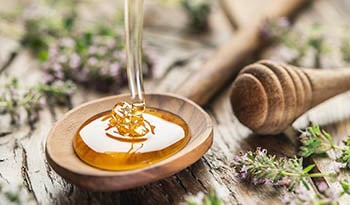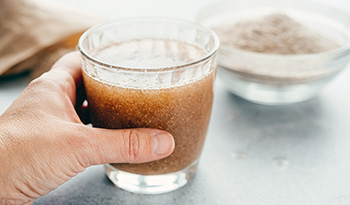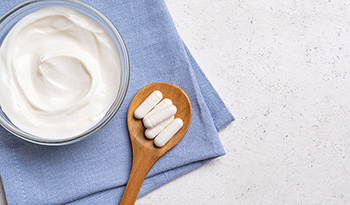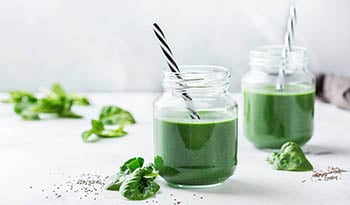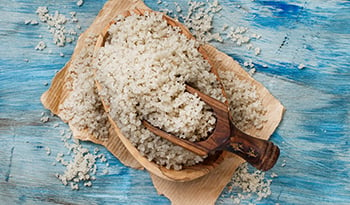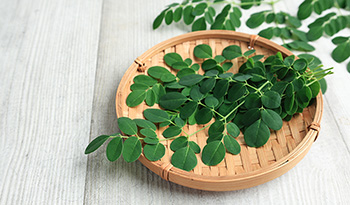Acacia: Uses and Health Benefits

Acacia gum is a dietary fiber that provides numerous functional properties and health benefits, from helping support digestive and oral health to reducing cholesterol levels and supporting weight loss. While food and beverage manufacturers commonly use acacia gum, known as food additive e414, as a texturizing agent, it can also be used at home to boost soluble fiber intake and improve the texture of cooked, baked, and beverage recipes.
What Is Acacia?
Acacia is a natural gum that comes from the hardened sap of two species of acacia tree. Also referred to as gum arabic or acacia fiber, this tasteless gum is a source of soluble fiber that dissolves in water and has long been used for its medicinal properties. It is harvested from acacia trees that grow in the dry, desert regions of Africa.
Acacia gum is typically available in gum form, which has a glassy nugget-like consistency, a pink, yellow, golden hue, and a naturally sticky texture. Once harvested and processed, acacia gum can be found in the form of a nugget, powder, or capsule.
Acacia Health Benefits
Acacia fiber offers numerous health benefits, including supporting gut and oral health, promoting healthy cholesterol levels, and helping manage a healthy weight.
Good Source of Fiber
Acacia gum is most notable for supporting digestive health due to its high soluble fiber content. A diet rich in fiber can:
- Support regular bowel movements
- Shorten digestive transit time, the time it takes food to pass through the intestinal tract
- Prevent constipation
- Lower cholesterol
- Support balanced blood sugar levels
- Support a healthy weight
- Positively impact the gut microbiome
- Support heart health
- Lower the risk of certain cancers
The average recommended daily intake of fiber is 38 grams for men and 25 grams for women. However, only an estimated one in five adults meet these fiber recommendations. Fiber is found naturally in plant-based foods like fruits, vegetables, whole grains, nuts, seeds, legumes, and herbs. By eating more plant-based foods and adding fiber-rich supplements like psyllium husk or acacia fiber, you can naturally consume an adequate amount of fiber.
There are two main types of fiber—soluble and insoluble. The body needs both for optimal health.
- Soluble fiber: Helps improve satiety (feeling full), supports better blood sugar levels, and lowers cholesterol levels. Foods rich in soluble fiber include legumes, peas, oats, barley, apples, bananas, nuts, chia seeds, citrus fruits, many berries, and more!
- Insoluble fiber: Good for colon health and can ease and prevent constipation. Food rich in insoluble fiber include legumes, green beans, potatoes, cauliflower, nuts, and whole wheat or bran products.
Many foods can be a source of both insoluble and soluble fiber!
Helps Wound Healing
Acacia may be used topically to support wound healing. The leaves and gum of the acacia tree have medicinal benefits, including antibacterial, anti-inflammatory, and antihistamine properties. To use acacia gum topically, mix three parts acacia powder with one part water to create a paste and apply to the wound.
Promotes Oral Health
Oral health encompasses the health of a person’s teeth, gums, and oral-facial system. Oral health affects gut health—and gut health can also impact oral health. Proper oral health goes beyond brushing and flossing for healthy teeth. The foods and drinks a person consumes, the oral products they use, and even how they breathe at night can impact oral health and health overall. Good habits for oral health include:
- Brushing and flossing daily
- Breathing through one’s nose at night, as opposed to mouth breathing
- Eating a healthy diet of real, whole foods, including plenty of fruits and vegetables, while limiting added sugars from packaged and processed foods
When used in an herbal mouthwash or toothpaste, acacia’s anti-inflammatory and antibacterial properties may help prevent gingivitis, support gum health, and improve oral health overall. For an at-home remedy, try mixing a pinch of acacia powder into your serving of toothpaste.
Supports Gut Health
The human gastrointestinal system is a complex system that includes the mouth, throat, esophagus, stomach, small intestine, large intestine, rectum, and anus. It is a microbial ecosystem that includes tens of trillions of microorganisms!
When an imbalance of bad to good bacteria, known as gut dysbiosis, is left untreated, digestive issues like irritable bowel syndrome (IBS), small intestinal bacterial overgrowth (SIBO), intestinal permeability (leaky gut), constipation, and diarrhea can arise. This not only affects digestion, it can also negatively impact immune and cognitive health.
Prebiotic fiber and probiotic-rich foods are key to supporting optimal gut health. Acacia gum is a source of soluble prebiotic fiber, which supports the gut microbiome and bacterial diversity. Prebiotics are naturally found in fiber-rich foods, such as garlic, onion, asparagus, Jerusalem artichoke, bananas, dandelions, leeks, and many more. Prebiotics are the food for probiotics, or “good” gut bacteria.
For optimal gut health, the body needs optimal good bacteria. A diverse diet of fiber-rich foods from plants can support bacterial diversity and gut health. Acacia fiber can be consumed regularly as part of a gut-healthy diet.
Supports Weight Management
Eating a fiber-rich diet can also support fat loss, reduce belly fat, and support weight management. Fiber provides many health benefits, including supporting healthy gut bacteria, improving satiety after eating, and helping manage overall caloric intake. High-fiber foods include fruits, vegetables, legumes, oats, psyllium husk, chia seeds, and acacia fiber.
Research suggests consuming 30 grams of fiber daily may help a person lose weight, lower blood pressure, and improve insulin response.1 In one study, women who consumed 30 grams of acacia gum daily for 6 weeks significantly reduced their body mass index and body fat percentage compared to those who consumed a placebo.2
Sore Throat Relief
Acacia fiber may also help soothe a sore throat and cough due to its ability to relieve irritation and fight inflammation. Adding a teaspoon of acacia fiber to a cup of hot water may relieve a sore throat. A cup of tea made with honey and acacia fiber may provide further sore throat relief.
Potential Side Effects of Acacia Gum
All-natural acacia gum is natural, gluten-free, low in calories, and tolerated by most people when used in small amounts. Acacia gum is suitable for a variety of diets, including vegan, vegetarian, paleo, and keto. It’s even FODMAP-diet-friendly. Up to 30 grams of acacia gum per day can be consumed safely for six weeks.
Acacia Gum Precautions
Minor side effects of consuming acacia gum may include gas, nausea, and bloating. Individuals who are allergic to bark from the quillaja tree, also known as the soap bark tree or soapbark, may experience an allergic reaction to acacia gum.
Acadia Gum Drug Interactions
Acacia gum may prevent the body from absorbing the antibiotic amoxicillin (Amoxil, Trimox).
Due to its higher fiber content, acacia gum should be consumed at least one hour after taking medications by mouth, as the fiber can interfere with the body’s ability to absorb medication.
How to Use Acacia Gum
Acacia gum can be dissolved in cold or hot water and used in various ways to add soluble fiber to cooking, baking, and beverage recipes. It is also widely used for its emulsifying properties to help recipes hold and bind together and provide a smooth texture.
- Baking: Add acacia powder to baked recipes from muffins and cookies to bread and cakes
- Cooking: Add acacia powder to soups, sauces, or salad dressings
- Drinks: Add acacia powder to beverages like coffee, tea, and smoothies
Gut-Healthy Acacia Fiber Smoothie
Makes 1 Serving
Ingredients:
- 1 banana, peeled
- ¼ cup spinach
- 1 tablespoon acacia fiber (powder)
- 1 tablespoon frozen blueberries (or berry of choice)
- 1 tablespoon chia seeds
- 1 tablespoon almond butter (or nut butter of choice)
- 1 cup water or unsweetened non-dairy milk
- ¼ cup ice
Directions:
Add all ingredients to a high-speed blender and blend until smooth and creamy.
Acacia Fiber Apple Cinnamon Chia Pudding
Makes 1 Serving
Ingredients:
- 1 cup unsweetened almond milk (or milk of preference)
- 1/4 cup whole chia seeds
- 1 tablespoon acacia fiber (powder)
- 1 tablespoon real maple syrup
- 1 teaspoon ground cinnamon
- 1/4 teaspoon ground ginger
- 2 tablespoons diced apples
Directions:
Add almond milk, chia seeds, acacia fiber, maple syrup, cinnamon, and ginger to a small glass jar or container and mix together. Then, fold in diced apples. Store the pudding in the fridge overnight. In the morning, stir the pudding together and enjoy!
The Versatility of Acacia Fiber!
Acacia gum is a natural by-product of acacia trees and is tolerated well by many. Acacia gum, or acacia fiber, can easily be added to beverages, cooking, or baking to increase one’s soluble fiber intake. Using acacia fiber regularly, along with a fiber-rich diet and healthy lifestyle habits, can support gut health and health overall!
References:
- Ma Y, Olendzki BC, Wang J, et al. Single-Component Versus Multicomponent Dietary Goals for the Metabolic Syndrome. 2015;162(4):248-257.
- Babiker R, Merghani TH, Elmusharaf K, Badi RM, Lang F, Saeed AM. Effects of gum Arabic ingestion on body mass index and body fat percentage in healthy adult females: Two-arm randomized, placebo controlled, double-blind trial. Nutr J. 2012;11(1):1-7.
ODRICANJE OD ODGOVORNOSTI: Ovaj Wellness kutak nije namijenjen za pružanje dijagnoza...





































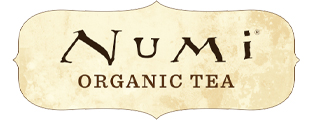











































 Sadržaj
Sadržaj








